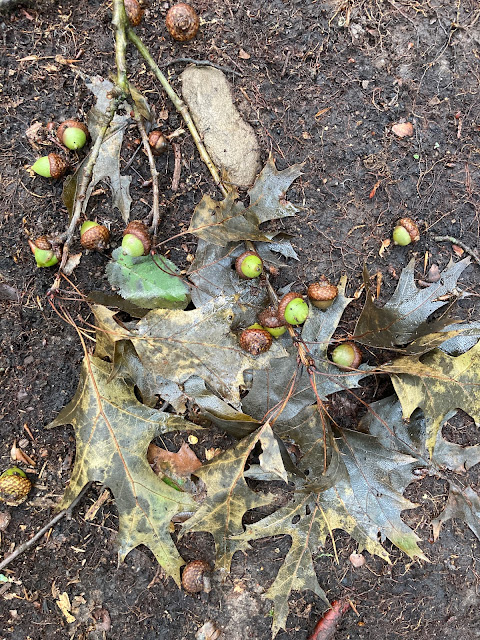There are gluts of acorns on the ground right now. This year looks like a mast year for oaks--a bumper crop of acorns. Mast is used to describe the fruit of woody plants associated with forests. A mast year refers to the simultaneous, abundant fruit production within a population of trees.
How big is a bumper crop compared to non-mast years? Mike Hallworth, Vermont Atlas of Life, quantifies the difference between mast and non-mast years: "During mast years, there may be anywhere between a 3- to 9-fold increase in the amount of nuts and cones." Many of the acorns I observe are the fruits of trees in the red oak group, for example Northern Red Oak (Quercus rubra) and Pin Oak (Q. palustris). I have seen very few white oak acorns. Oaks in this group include Swamp White Oak (Q. bicolor) and White Oak (Q. alba).
One of the differences between these two groups of oaks is the maturation of their fruit. White oak acorns ripen in the same year the female flowers are fertilized while red oak acorns mature in the year after fertilization.
Two other distinctions between the oak groups are wood color and leaf morphology. The latter is more visible to the naked eye and you don't have to cut the tree. Oaks have lobed leaves; most of them do anyway. The lobes of white oak leaves are round. The lobes of red oak leaves are pointed with bristled tips. White oak wood is lighter in color than red oak wood--an outcome of the concentration of tannins, says Carey Russell, a NY-based forestry educator.
By the way, white oaks' acorns are more palatable to wildlife and people because they have less tannic acid. Other plants contain tannins (tannic acid) but the name is derived from "the old German word tanna meaning oak. It refers to the use of wood tannins derived from oak trees that were used to convert animal hides into leather."
The internet says that mast years in oaks occur every two to five years. I have not found a scientific source for this popular statement. A news search revealed 2021 was the most recent mast year. Mike Hallworth predicted this occurrence based on differences in summer temperatures in 2019 and 2020. Is 2023 a mast year? It has been two years since the last one!
If you come across white oak acorns, collect them but not too many. Leave some for wildlife and forest regeneration. The "acorn predators"--jays, woodpeckers, turkeys, mice, squirrels, deer--who have survived the lean years deserve to be satisfied too. Trees synchronize their fruit production to overwhelm frugivores to ensure seed survival. This concept is known as predator satiation was hypothesized by Daniel Jansen in 1971 (via Dave Kelly 2020). Red oak acorns are edible, but you might want to remove much of their tannins.
American Beech seems to be experiencing a boom year, too. Which trees in your area are profusely fruiting this year?






Comments
Post a Comment
Thank you for commenting on this post!